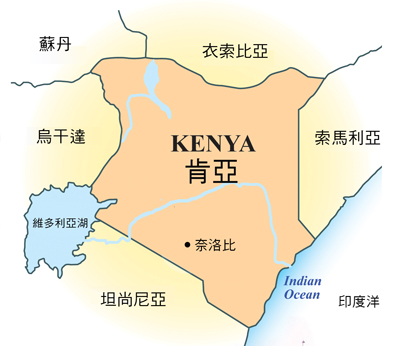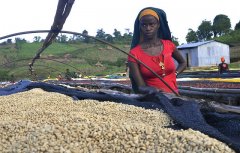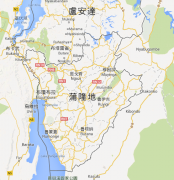Kenya Wuxiaofu processing Plant Information material East Africa Taste of Harvest Kenya No. 5

For professional baristas, please follow the coffee workshop (Wechat official account cafe_style)
The delicacy and special flavor of Kenyan coffee
Although Kenya and Ethiopia are adjacent to each other and both are big coffee producers in Africa, there are obvious differences in coffee varieties and flavors. Kenyan coffee is mainly characterized by its strong berry aroma, grapefruit and black plum acidity, sugarcane sweetness, layered and moderate mellow, so it is loved by many coffee lovers.
Because the equator runs through the middle of the country, and the overall border is within 10 degrees north and south latitude, Kenya has two rainy seasons every year and can harvest coffee twice. Coffee is mainly grown in volcanic areas 1600-2100 meters from the capital Nairobi to the mountains of Kenya, as well as Mount Elgon on the border with Uganda.
The special flavor of Kenyan coffee comes from two unique ways:
A unique variety
Although Kenya has introduced bourbon species, India's Kent, and Jamaica's Blue Mountain Tibica, the world-famous bourbon varieties SL28 and SL34 first appeared in Kenya in the 1930s. These two varieties give Kenyan coffee a unique sour BlackBerry flavor.
Kenyan washing method
Kenyan coffee is famous for its rich layers and clean taste. Its unique Kenyan-style water washing method goes through two water-washing and fermentation procedures, commonly known as "double fermentation". It is a rather complicated but delicate method of raw bean treatment. This treatment is more time-consuming and water-consuming than ordinary water washing, so Kenyan coffee is more expensive, but it is also an indispensable method to create a unique sour flavor and clean taste of Kenyan coffee.
First washing and fermentation
After the coffee cherry harvest, the beans will first be picked by the specific gravity of the water flow; the principle is that the coffee fruit itself is screened by the difference in density and quality; the coffee beans with high density (heavy weight) will sink into the water, while the coffee beans with low density will float. The coffee fruits with high mature quality have high density, so they are screened out for further treatment.
After the high-quality and ripe fruits are selected, the peel is removed, washed and soaked, and the pectin mucus attached to the outer layer of raw beans is fermented. Pectin has natural sugars and alcohols, which play an important role in the development of sweetness, acidity and overall flavor of coffee.
The fermentation time is as long as 24 hours. after fermentation, 80% of the pectin can be removed, leaving only the flavor in the coffee beans.
The second washing and fermentation
Then enter the second washing and fermentation process. After the coffee beans in the previous stage are cleaned, they are soaked in water for 12 hours and 24 hours. This process increases proteins and amino acids, and the acidity of coffee beans creates complex and delicate layers of taste.
Finally, remove all the remaining pectin and move the coffee beans to a high shelf for sun drying, depending on the weather, which usually takes about 5 to 10 days to complete.

Introduction of Kenya Qianbutanoen Bean Valley / Wuxiaofu processing Plant
Tano Ndogo Wuxiaofu processing Plant
Tano Ndogo is the local Swahili language, meaning "Little Five". It refers to the five families that founded the system, including three brothers and two neighbors of the Muuru family (Gichega Manor and Kariru Manor). Muuru is now passed on to the Joseph, Francis and James brothers, plus the other two neighbors' two estates, each of which is only about 3.3ha, which is a very small batch. Through the cooperation of the five estates, in addition to maintaining their operational independence, but also maintaining source traceability.
In this year's Taste of Harvest regional finals in East Africa, where the top three winners competed with each other, it was not surprising that Ethiopia was the biggest winner, with all three beans in the top five. However, what surprised the cup test table was a Kenyan bean, the Kenyan Fram Farm who finally won the championship.
James Kariuki, the owner of Fram Farm, and the three brothers of Wuxiaofu processing Plant are also cousins, which can be said to be in the same family. Our exporter partner in Kenya selected two beans from the family to enter the market this year. One won the championship and the other won the fifth place, which can be said to be very accurate.
Product name: Kenya Kiambu Tano Ndogo AA TOP Auction Lot
Production area: Gitwei, Kiambu
Sea pull: 1850m
Products: SL28, SL34
Producers: Joseph, Francis and James brothers
Processing plant: Tano Ndogo
Grade: double hand-picked, AA TOP
Sea pull: 1800m
Treatment: Kenyan washing
Flavor description: black plum, plum, currant, longan honey, high sweetness.
Important Notice :
前街咖啡 FrontStreet Coffee has moved to new addredd:
FrontStreet Coffee Address: 315,Donghua East Road,GuangZhou
Tel:020 38364473
- Prev

Information material of Osaya Cooperative in Kaili, Kenya double fermentation by Kenyan washing method
For the exchange of professional baristas, please follow the coffee workshop (Wechat official account cafe_style) Kenya is located in eastern Africa, Kenya became independent from the United Kingdom on December 12, 1963. Kenya is a member of the East African Community, and the five countries of the East African Community proposed to merge into a unified federal state in 2015. The federation will have a common constitution, president, parliament and currency. Kenyan coffee
- Next

Coffee producing area of Cayansa Province, Burundi introduces the history and current situation of coffee cultivation in Burundi.
For professional baristas, please follow the coffee workshop (official Wechat account cafe_style) about Burundian Coffee Burundi is a small landlocked country in central Africa on the Great Rift Valley, bordering Tanzania, Congo and Rwanda. It is slightly smaller than Taiwan and has a large population, making it the second most densely populated area in Africa. There are great ups and downs in the territory, and there is a famous tan in the southwest.
Related
- Detailed explanation of Jadeite planting Land in Panamanian Jadeite Manor introduction to the grading system of Jadeite competitive bidding, Red bid, Green bid and Rose Summer
- Story of Coffee planting in Brenka region of Costa Rica Stonehenge Manor anaerobic heavy honey treatment of flavor mouth
- What's on the barrel of Blue Mountain Coffee beans?
- Can American coffee also pull flowers? How to use hot American style to pull out a good-looking pattern?
- Can you make a cold extract with coffee beans? What is the right proportion for cold-extracted coffee formula?
- Indonesian PWN Gold Mandrine Coffee Origin Features Flavor How to Chong? Mandolin coffee is American.
- A brief introduction to the flavor characteristics of Brazilian yellow bourbon coffee beans
- What is the effect of different water quality on the flavor of cold-extracted coffee? What kind of water is best for brewing coffee?
- Why do you think of Rose Summer whenever you mention Panamanian coffee?
- Introduction to the characteristics of authentic blue mountain coffee bean producing areas? What is the CIB Coffee Authority in Jamaica?

